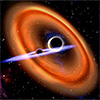| Oct 28, 2025 |
LIGO-Virgo-KAGRA detects two black hole mergers with rare spin patterns, offering evidence for hierarchical formation and testing Einstein’s theory.
|
|
(Nanowerk News) In a new paper published in The Astrophysical Journal Letters (“GW241011 and GW241110: Exploring Binary Formation and Fundamental Physics with Asymmetric, High-Spin Black Hole Coalescences”), the international LIGO-Virgo-KAGRA Collaboration reports on the detection of two gravitational wave events in October and November of last year with unusual black hole spins. An observation that adds an important new piece to our understanding of the most elusive phenomena in the universe.
|
|
Gravitational waves are “ripples” in space-time that result from cataclysmic events in deep space, with the strongest waves produced by the collision of black holes.
|
|
Using sophisticated algorithmic techniques and mathematical models, researchers are able to reconstruct many physical features of the detected black holes from the analysis of gravitational signals, such as their masses and the distance of the event from Earth, and even the speed and direction of their rotation around their axis, called spin.
|
 |
| Illustration of Binary Black Hole Merger. (Image: Carl Knox, OzGrav, Swinburne University of Technology)
|
|
The first merger detected on Oct. 11, 2024 (GW241011), occurred roughly 700 million light years away and resulted from the collision of two black holes weighing in at around 17 and 7 times the mass of our sun. The larger of the two black holes in GW241011 was measured to be one of the fastest rotating black holes observed to date.
|
|
Almost one month later, GW241110 was detected on Nov. 10, 2024, coming from around 2.4 billion light years away and involving the merger of black holes roughly 16 and 8 times the mass of our sun. While most observed black holes spin in the same direction as their orbit, the primary black hole of GW241110 was noted to be spinning in a direction opposite its orbit – a first of its kind.
|
|
“Each new detection provides important insights about the universe, reminding us that each observed merger is both an astrophysical discovery but also an invaluable laboratory for probing the fundamental laws of physics,” says paper co-author Carl-Johan Haster, assistant professor of astrophysics at the University of Nevada, Las Vegas (UNLV). “Binaries like these had been predicted given earlier observations, but this is the first direct evidence for their existence.”
|
|
Both detections, interestingly, point toward the possibility of “second-generation” black holes.
“GW241011 and GW241110 are among the most novel events among the several hundred that the LIGO-Virgo-KAGRA network has observed,” says Stephen Fairhurst, professor at Cardiff University and spokesperson of the LIGO Scientific Collaboration. “With both events having one black hole which is both significantly more massive than the other and rapidly spinning, they provide tantalizing evidence that these black holes were formed from previous black hole mergers.”
|
|
Scientists point to certain clues, including the size differential between the black holes in each merger – the larger was nearly double the size of the smaller – and the spin orientations of the larger of the black holes in each event. A natural explanation for these peculiarities is that the black holes are the result of earlier coalescences. This process, called a hierarchical merger, suggests that these systems formed in dense environments, in regions like star clusters, where black holes are more likely to run into each other and merge again and again.
|
|
“These detections highlight the extraordinary capabilities of our global gravitational wave observatories,” says Gianluca Gemme, spokesperson of the Virgo Collaboration. “The unusual spin configurations observed in GW241011 and GW241110 not only challenge our understanding of black hole formation but also offer compelling evidence for hierarchical mergers in dense cosmic environments: they teach us that some black holes exist not just as isolated partners but likely as members of a dense and dynamic crowd. These discoveries underscore the importance of international collaboration in unveiling the most elusive phenomena in the universe.”
|
Uncovering Hidden Properties of Black Hole Mergers
|
|
Gravitational waves were first predicted by Albert Einstein as part of his general theory of relativity in 1916, but their presence – though proven in the 1970s – wasn’t directly observed by scientists until just 10 years ago, when the LIGO and Virgo scientific collaborations announced the detection of the waves as the result of a black hole merger.
|
|
Today, LIGO-Virgo-KAGRA is a worldwide network of advanced gravitational-wave detectors and is close to the end of its fourth observing run, O4. The current run started in late May 2023 and is expected to continue through mid-November of this year. To date, approximately 300 black hole mergers have been observed through gravitational waves, including candidates identified in the ongoing O4 run that are awaiting final validation.
|
|
Furthermore, in the case of the observation announced today, the precision with which GW241011 was measured also allowed key predictions of Einstein’s theory of general relativity to be tested under extreme conditions.
|
|
Actually this event can be compared to predictions from Einstein’s theory and mathematician Roy Kerr’s solution for rotating black holes. The black hole’s rapid rotation slightly deforms it, leaving a characteristic fingerprint in the gravitational waves it emits. By analyzing GW241011, the research team found excellent agreement with Kerr’s solution and verified, once again, Einstein’s prediction, but with unprecedented accuracy.
|
Additionally, because the masses of the individual black holes differ significantly, the gravitational-wave signal contains the “hum” of a higher harmonic – similar to the overtones of musical instruments, seen only for the third time ever in GW241011. One of these harmonics was observed with superb clarity and confirms another prediction from Einstein’s theory.
“This discovery also means that we’re more sensitive than ever to any new physics that might lie beyond Einstein’s theory.” says Haster.
|
Advanced Search for Elementary Particles
|
|
Rapidly rotating black holes like those observed in this study have yet another application – in particle physics. Scientists can use them to test whether certain hypothesized light-weight elementary particles exist and how massive they are.
|
|
These particles, called ultralight bosons, are predicted by some theories that go beyond the Standard Model of particle physics, which describes and classifies all known elementary particles. If ultralight bosons exist, they can extract rotational energy from black holes. How much energy is extracted and how much the rotation of the black holes slows down over time depends on the mass of these particles, which is still unknown.
|
|
The observation that the massive black hole in the binary system that emitted GW241011 continues to rotate rapidly even millions or billions of years after it formed rules out a wide range of ultralight boson masses.
|
|
“The detection and inspection of these two events demonstrate how important it is to operate our detectors in synergy and to strive to improve their sensitivities,” says Francesco Pannarale, professor at Sapienza – University of Rome and co-chair of the Observational Science Division of the LIGO-Virgo-KAGRA Collaborations. “The LIGO and Virgo instruments taught us yet some more about how black hole binaries can form in our Universe,” he adds, “as well as about the fundamental physics that regulates them at the very essence. By upgrading our instruments, we will be able to dive deeper into these and other aspects with the increased precision of our measurements.”
|


